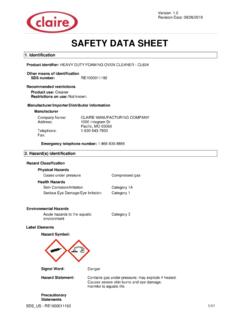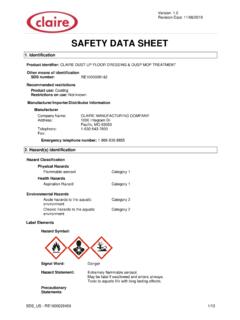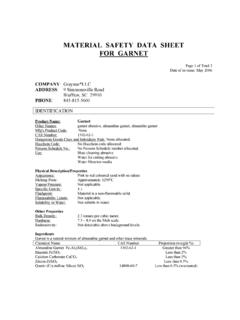Transcription of SAFETY DATA SHEET - The Claire Manufacturing Company
1 SAFETY data SHEET . 1. Identification product number 1000003940. product identifier CITRUS blast METERED AIR FRESHENER. Company information Claire Manufacturing Co. 1005 S. Westgate Drive Addison, IL 60101 United States Company phone General Assistance 1-630-543-7600. Emergency telephone US 1-866-836-8855. Emergency telephone outside 1-952-852-4646. US. Version # 01. Recommended use Air Freshener Recommended restrictions None known. 2. Hazard(s) identification Physical hazards Flammable aerosols Category 1. Health hazards Serious eye damage/eye irritation Category 2A. Specific target organ toxicity, single exposure Category 3 narcotic effects Environmental hazards Not classified. OSHA defined hazards Not classified. Label elements Signal word Danger Hazard statement Extremely flammable aerosol.
2 Causes serious eye irritation. May cause drowsiness or dizziness. Precautionary statement Prevention Keep away from heat/sparks/open flames/hot surfaces. - No smoking. Do not spray on an open flame or other ignition source. Pressurized container: Do not pierce or burn, even after use. Avoid breathing gas. Wash thoroughly after handling. Use only outdoors or in a well-ventilated area. Wear eye/face protection. Response If inhaled: Remove person to fresh air and keep comfortable for breathing. If in eyes: Rinse cautiously with water for several minutes. Remove contact lenses, if present and easy to do. Continue rinsing. Call a poison center/doctor if you feel unwell. If eye irritation persists: Get medical advice/attention. Storage Store in a well-ventilated place. Keep container tightly closed.
3 Store locked up. Protect from sunlight. Do not expose to temperatures exceeding 50 C/122 F. Disposal Not available. Hazard(s) not otherwise None known. classified (HNOC). Supplemental information None. 3. Composition/information on ingredients Mixtures Chemical name Common name and synonyms CAS number %. Acetone 67-64-1 60 - 80. Butane 106-97-8 10 - 20. Propane 74-98-6 10 - 20. product name: CITRUS blast METERED AIR FRESHENER SDS US. product #: 1000003940 Version #: 01 Issue date: 05-25-2015 1/9. Chemical name Common name and synonyms CAS number %. Diethylene Glycol Monoethyl Ether 111-90-0 - 10. Other components below reportable levels - 10. *Designates that a specific chemical identity and/or percentage of composition has been withheld as a trade secret. 4. First-aid measures Inhalation Remove victim to fresh air and keep at rest in a position comfortable for breathing.
4 Call a POISON. CENTER or doctor/physician if you feel unwell. Skin contact Wash off with soap and water. Get medical attention if irritation develops and persists. Eye contact Rinse with water. Get medical attention if irritation develops and persists. Ingestion Rinse mouth. Get medical attention if symptoms occur. Most important May cause drowsiness and dizziness. Headache. Nausea, vomiting. Irritation of nose and throat. symptoms/effects, acute and Severe eye irritation. Symptoms may include stinging, tearing, redness, swelling, and blurred delayed vision. Indication of immediate Provide general supportive measures and treat symptomatically. Keep victim under observation. medical attention and special Symptoms may be delayed. treatment needed General information Ensure that medical personnel are aware of the material(s) involved, and take precautions to protect themselves.
5 5. Fire-fighting measures Suitable extinguishing media Alcohol resistant foam. Water fog. Dry chemical powder. Carbon dioxide (CO2). Unsuitable extinguishing Do not use water jet as an extinguisher, as this will spread the fire. media Specific hazards arising from Contents under pressure. Pressurized container may explode when exposed to heat or flame. the chemical Special protective equipment Firefighters must use standard protective equipment including flame retardant coat, helmet with and precautions for firefighters face shield, gloves, rubber boots, and in enclosed spaces, SCBA. Fire-fighting Move containers from fire area if you can do so without risk. Containers should be cooled with equipment/instructions water to prevent vapor pressure build up. For massive fire in cargo area, use unmanned hose holder or monitor nozzles, if possible.
6 If not, withdraw and let fire burn out. Specific methods Use standard firefighting procedures and consider the hazards of other involved materials. Move containers from fire area if you can do so without risk. In the event of fire and/or explosion do not breathe fumes. General fire hazards Extremely flammable aerosol. 6. Accidental release measures Personal precautions, Keep unnecessary personnel away. Keep people away from and upwind of spill/leak. Keep out of protective equipment and low areas. Wear appropriate protective equipment and clothing during clean-up. Avoid breathing emergency procedures gas. Do not touch damaged containers or spilled material unless wearing appropriate protective clothing. Ventilate closed spaces before entering them. Local authorities should be advised if significant spillages cannot be contained.
7 For personal protection, see section 8 of the SDS. Methods and materials for Refer to attached SAFETY data sheets and/or instructions for use. Eliminate all ignition sources (no containment and cleaning up smoking, flares, sparks, or flames in immediate area). Keep combustibles (wood, paper, oil, etc.). away from spilled material. Stop leak if you can do so without risk. Move the cylinder to a safe and open area if the leak is irreparable. Isolate area until gas has dispersed. Prevent entry into waterways, sewer, basements or confined areas. For waste disposal, see section 13 of the SDS. Environmental precautions Avoid discharge into drains, water courses or onto the ground. 7. Handling and storage Precautions for safe handling Pressurized container: Do not pierce or burn, even after use. Do not use if spray button is missing or defective.
8 Do not spray on a naked flame or any other incandescent material. Do not smoke while using or until sprayed surface is thoroughly dry. Do not cut, weld, solder, drill, grind, or expose containers to heat, flame, sparks, or other sources of ignition. All equipment used when handling the product must be grounded. Do not re-use empty containers. Avoid breathing gas. Avoid contact with eyes. Avoid prolonged exposure. Use only in well-ventilated areas. Wear appropriate personal protective equipment. Observe good industrial hygiene practices. product name: CITRUS blast METERED AIR FRESHENER SDS US. product #: 1000003940 Version #: 01 Issue date: 05-25-2015 2/9. Conditions for safe storage, Level 3 Aerosol. including any incompatibilities Store locked up. Pressurized container. Protect from sunlight and do not expose to temperatures exceeding 50 C/122 F.
9 Do not puncture, incinerate or crush. Do not handle or store near an open flame, heat or other sources of ignition. This material can accumulate static charge which may cause spark and become an ignition source. Refrigeration recommended. Store away from incompatible materials (see Section 10 of the SDS). 8. Exposure controls/personal protection Occupational exposure limits US. OSHA Table Z-1 Limits for Air Contaminants (29 CFR ). Components Type Value Acetone (CAS 67-64-1) PEL 2400 mg/m3. 1000 ppm Propane (CAS 74-98-6) PEL 1800 mg/m3. 1000 ppm US. ACGIH Threshold Limit Values Components Type Value Acetone (CAS 67-64-1) STEL 750 ppm TWA 500 ppm Butane (CAS 106-97-8) STEL 1000 ppm US. NIOSH: Pocket Guide to Chemical Hazards Components Type Value Acetone (CAS 67-64-1) TWA 590 mg/m3. 250 ppm Butane (CAS 106-97-8) TWA 1900 mg/m3.
10 800 ppm Propane (CAS 74-98-6) TWA 1800 mg/m3. 1000 ppm US. Workplace Environmental Exposure Level (WEEL) Guides Components Type Value Diethylene Glycol TWA 140 mg/m3. Monoethyl Ether (CAS. 111-90-0). 25 ppm Biological limit values ACGIH Biological Exposure Indices Components Value Determinant Specimen Sampling Time Acetone (CAS 67-64-1) 50 mg/l Acetone Urine *. * - For sampling details, please see the source document. Appropriate engineering Good general ventilation (typically 10 air changes per hour) should be used. Ventilation rates controls should be matched to conditions. If applicable, use process enclosures, local exhaust ventilation, or other engineering controls to maintain airborne levels below recommended exposure limits. If exposure limits have not been established, maintain airborne levels to an acceptable level.








